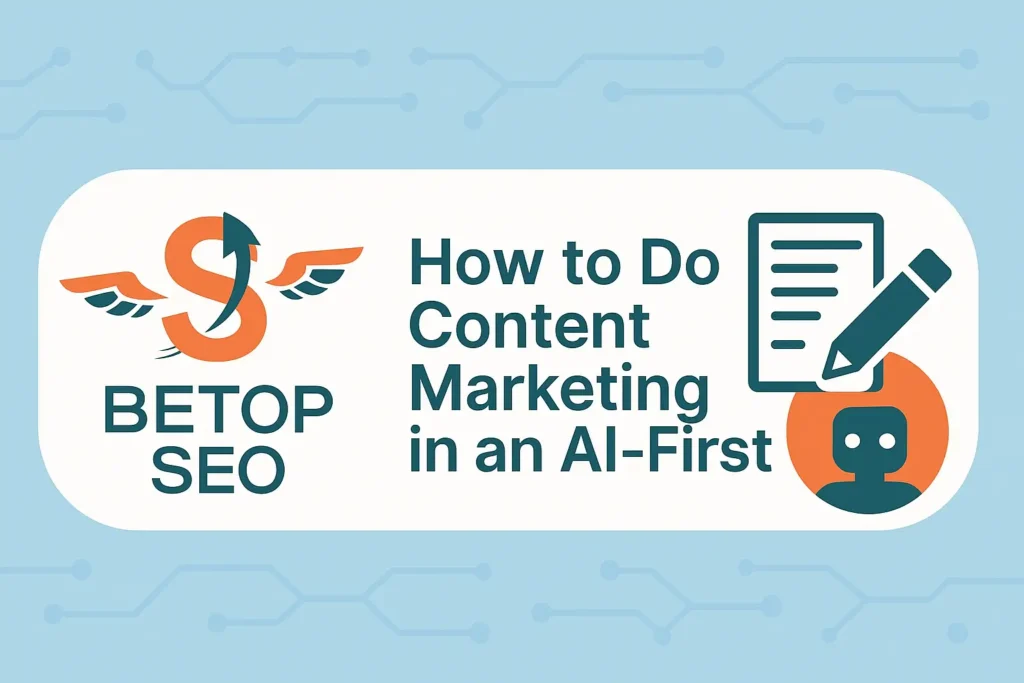Table of Contents
ToggleKey Takeaways
- AI-first content marketing requires a strategic blend of human creativity and intelligent automation.
- Success is driven by deep audience insights, conversational and intent-driven keyword research, and structured, value-rich content.
- Optimizing for AI Overviews and generative search tools is essential for discoverability.
- Personalization at scale and workflow automation are now standard, but maintaining brand voice is non-negotiable.
- Continuous learning, ethical AI adoption, and adaptability separate market leaders from the rest.
What Is Content Marketing in an AI-First World?
AI-first content marketing combines the strengths of artificial intelligence with human storytelling, allowing brands to create, optimize, personalize, and distribute content more efficiently and effectively than ever before. In the AI era, content isn’t just produced—it’s intelligently guided, precisely targeted, and dynamically updated to match evolving user needs and search behaviors.
Why Is AI Transforming Content Marketing?
AI tools analyze vast datasets, identify trending topics, optimize keyword targeting, personalize messaging, and automate repetitive tasks. Brands use AI platforms to:
- Detect emerging search patterns before competitors.
- Segment audiences and deliver relevant content at scale.
- Streamline content operations, freeing marketers to focus on creative strategy.
- Improve visibility in AI-powered search and overviews, such as Google’s AI Overviews and ChatGPT citations.
Core Strategies for AI-First Content Marketing
1. Deep Audience Insights
AI-powered analytics help marketers understand audience behavior, sentiment, lifecycle stage, and search intent. Use AI tools to:
- Analyze customer interactions across platforms.
- Identify content gaps and hidden opportunities.
- Personalize recommendations and content paths for individual users.
2. Keyword Research for AI Overviews
AI-powered search and generative engines prioritize long-tail, intent-driven keywords, especially those matching question-based queries.
Best practices:
- Use tools like Ahrefs, SEMrush, Google’s PAA, and AnswerThePublic to uncover specific, conversational queries.
- Focus on informational keywords (“how to,” “what is,” “why,” “best ways to…”).
- Integrate LSI and semantic keywords for richer context.
BeTopSEO helps you with in-depth keyword research for search intent to longtail keywords.
AI-Driven Content Creation and Optimization
1. Human Creativity + AI Workflow
Successful content teams are blending AI efficiency with human creativity:
- Use AI to brainstorm topics, draft outlines, or even first drafts.
- Edit and refine with a human touch, ensuring brand voice and authenticity.
- Automate repetitive tasks (scheduling, optimization, simple updates).
2. Structuring Content for AI Search & Overviews
AI algorithms—and users—love structured, scannable content that answers specific questions clearly:
- Use direct answers, bullet points, and clear headings (H2s and H3s).
- Employ tables and lists for data, comparisons, steps, and summaries.
- Format for featured snippets, which are heavily used in AI Overviews and generative search results.
Table: Schema Types for Featured Snippets & AI Overviews
Personalization and 1:1 Marketing at Scale
AI enables true 1:1 marketing, serving tailored messages based on individual user profiles, behaviors, and goals.
Segment audiences (active, at-risk, dormant, prospects).
- Deliver contextually relevant content, increasing engagement and conversion rates.
- Reduce bounce rates and churn through hyper-relevance.
Workflow, Automation, and Efficiency Boosts
Modern content marketing teams operate smarter, not harder:
- Start with a single channel to integrate AI and learn before scaling.
- Develop clear prompts for AI tools; prompt engineering increases output quality.
- Automate scheduling, editing, distribution, and reporting to save time.
Ethics, Brand Voice, and Trust in the AI Era
- Document your company’s brand guidelines to ensure consistency, even with AI-generated drafts.
- Be transparent about AI use—maintain trust with users.
- Monitor content quality and adherence to E-E-A-T (Experience, Expertise, Authoritativeness, Trustworthiness).
Optimizing Content for AI Overviews and Tools
1.Target Complex, Question-Based Queries
- 99% of AI Overviews trigger for longer, question-based search terms (e.g. “how to increase content engagement with AI tools”).
- Provide both specific and comprehensive answers, incorporating supporting data and links.
2. Refresh and Update Content Regularly
- AI algorithms prefer new, data-rich, and up-to-date material.
- Update publish dates after refreshing content and resubmit for crawling.
3. Format for Featured Snippets
- Use direct answers at the top of sections.
- Break down steps or comparisons in lists/tables.
- Use semantic markup (FAQPage, HowTo, QAPage, Article) in your website’s code.
Advanced Techniques (2025 and Beyond)
Utilize Predictive Keyword Analysis
- AI can forecast trends and user questions before they hit the mainstream.
- Cover emerging topics early for first-mover advantage.
Create Multimedia-Rich Content
- AI is increasingly favoring video, infographics, and interactive formats.
- Use Video Object schema to surface in video carousels and visual search.
Measure AI Visibility
- Use tools to track featured snippets and citations in AI Overviews across platforms (Google, Bing AI, ChatGPT).
- Refine and adapt content based on performance analytics.
Conclusion
In a world where AI-first content marketing is now the norm, success comes from combining strategic automation with human creativity, deep audience insights, and structured, question-driven content. Optimize not just for legacy search, but for AI Overviews and generative engines, and invest in tools, tactics, and workflows that align with today’s digital reality.
FAQs: Content Marketing in an AI-First World
Content marketing now requires a blend of creative human storytelling and intelligent automation, focused on deep user understanding and optimization for AI search.
Target long-tail, informational keywords, provide direct answers, use structured data (FAQPage, HowTo schemas), and keep your content updated.
No; AI can improve research, speed, and personalization, but human creativity and brand voice remain crucial for authenticity and trust.
Popular platforms include ChatGPT, Jasper, Frase, Clearscope, MarketMuse, Surfer SEO, Ahrefs, and SEMrush for topic ideation, optimization, and analytics.
Refresh at least quarterly, and immediately when new data or trends emerge. AI search engines favor recently updated content.

